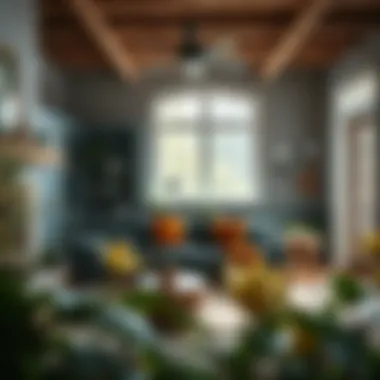Mastering Home Restoration: Insights from BrightLooms


Intro
Home restoration is more than just a trend; it's a movement towards preserving the stories that buildings tell. Every old wall and creaky floorboard holds memories and history. The efforts to restore and enhance these spaces not only breathe new life into tired structures but also promote sustainable living practices. Delving into this complex arena with BrightLooms offers splendid insights for homeowners looking to embark on their restoration journey. This guide will elaborate on innovative techniques, sustainable practices, and expert opinions. Homeowners, interior design aficionados, enthusiastic party hosts, and those who love gardening will find valuable nuggets of information throughout.
Design Inspiration
Restoration projects often begin with an idea—a flicker of inspiration that can guide the entire process. BrightLooms emphasizes the importance of finding design inspiration that resonates with both the character of the home and the lifestyle of its inhabitants.
Trending Styles and Themes
When considering home restoration, it's essential to tap into the latest styles while respecting historical elements. Vintage charm meets modern minimalism; rustic palettes vie for attention alongside sleek contemporary designs. Think about blending farmhouse aesthetics with industrial chic, or honoring a mid-century modern vibe while adding sustainable touches.
- Shabby Chic: This style embraces imperfections—think distressed furniture and soft, natural fabrics.
- Art Deco Revival: Bold colors and geometric shapes bring a touch of opulence, reminding us of the 1920s grandeur.
- Sustainable Practices: Rough-hewn beams with eco-friendly materials can successfully marry past and future.
Finding the right style requires a little digging. Local architecture, art exhibits, and boutiques often display these trending themes for inspiration.
Color Palettes and Combinations
Color is like the soul of any restoration effort. Selecting the right hues shapes how spaces are perceived. Incorporate both bold statements and soft accents for a comprehensive aesthetic.
- Earthy Tones: Warm browns, muted greens, and subtle beiges create a serene atmosphere.
- Navy and Gold Accents: Combining deep blue with metallics can impart luxury and sophistication.
- Pastels: Soft pinks or mint greens add a delicate touch, perfect for well-lit rooms.
Avoiding overly dramatic colors ensures a timeless feel, allowing future homeowners to appreciate the beauty long after completion.
"Restoration isn't about flipping houses; it's about enhancing lives and honoring craftsmanship."
Each scheme should reflect personal taste while remaining nostalgic, reminding us of the tales our homes have gathered over time.
Gardening Advice
Integrating outdoor spaces into the home restoration process is equally important, as gardens can enhance a property’s allure and offer a quiet retreat. BrightLooms suggests focusing on both function and aesthetics in garden design.
Seasonal Planting Guides
Understanding seasonal dynamics is crucial for a thriving garden. Choosing plants that complement the home's style enhances the overall look, giving it a cohesive feel. Here’s a brief guide:
- Spring: Brilliant blooms like tulips and daffodils pop up after winter’s end.
- Summer: Think vibrant sunflowers and lavenders for attractiveness and fragrance.
- Fall: Harvest-friendly options like pumpkins also add seasonal decor.
- Winter: Evergreens and holly maintain structure even in the cold months.
Maintenance and Care Tips
Regular upkeep can keep a garden flourishing. Here are simple tips:
- Water deeply but infrequently to encourage strong root development.
- Mulching helps to retain soil moisture and suppress weeds.
- Regular pruning ensures plants maintain their shape and promote new growth.
In comprising a multifaceted approach to home restoration—one that marries inspiring design with flourishing outdoor spaces—professionals and DIY enthusiasts alike can cultivate captivating environments that genuinely feel like home.
For added inspiration in your restoration journey, consider visiting websites like Wikipedia, Britannica, and engaging in communities at Reddit or Facebook. These resources offer further insight sharing knowledge on both historical practices and innovative trends.
The Essence of Home Restoration
Home restoration is not merely about fixing what’s broken or updating outdated elements; it encompasses a deeper, more intrinsic understanding of a space. This journey connects individuals with their environments, allowing them to reflect and rebuild meaningful relationships with the homes they inhabit. The importance of home restoration lies not just in aesthetics but also in preserving history, honoring craftsmanship, and creating sustainable living environments.
Understanding Home Restoration
To grasp the essence of home restoration, one needs to appreciate its multifaceted nature. Essentially, it merges the old and the new, blending tradition with modern methods. It’s a nuanced process that requires a thorough evaluation of a home’s condition, its architectural history, and the lifestyle of its inhabitants. Home restoration fosters a sense of belonging, giving homeowners the chance to imprint their identity onto a dwelling that, in many instances, is a piece of their community's fabric.
When embarking on restoration, it’s crucial to define the intent. Are you restoring a family heirloom that carries memories? Or perhaps rejuvenating a classic structure to enhance its functionality? Identifying the purpose guides all decisions, ensuring that the restoration aligns with your vision while remaining respectful of the home's roots.
Historical Significance in Restoration
Restoration often echoes the stories of the past. Understanding historical contexts adds layers of meaning to the work. Each brushstroke on a wall or piece of woodwork can signify an era rich in artistic styles and cultural shifts. For instance, consider a Victorian-era home adorned with intricate moldings and ornate fireplaces. Restoring such features isn’t just about visual appeal; it’s about preserving craftsmanship that reflects an entire period’s socio-cultural dynamics.
Moreover, acknowledging historical significance can foster pride and a sense of responsibility among community members. When a neighborhood sees its old buildings—as living representations of days gone by—it builds connections that span generations.
Sustainability in Restoration Practices
In an age where environmental concerns are rife, integrating sustainable practices into home restoration becomes increasingly critical. The choices made during the restoration process have far-reaching implications, both ecologically and economically. Utilizing eco-friendly materials, such as low-VOC paints and recycled fixtures, not only reduces one’s carbon footprint but also enhances the home’s air quality.
Reclaimed products, from timber to bricks, also play a significant role in sustainable restoration. These materials come with their own stories, reducing waste and providing unique character that new materials often can't replicate.
"Every restoration project you undertake is not just a renovation; it's an investment in the future of our planet."
Employing energy-efficient systems and modern insulation techniques further ensures that the home is not only beautiful but functional and eco-conscious. Homeowners increasingly recognize that sustainability is not merely a trend but a necessity, urging them to make decisions that resonate with their values and the environment.
Finale
In summary, home restoration is a nuanced discipline that intertwines history, identity, and sustainability. As homeowners reinforce their environments, they weave together threads of the past and the present. The work done in restoring homes has the potential to create lasting impressions, allowing individuals to dwell in spaces that resonate with warmth, significance, and responsibility for the future.
Assessing Your Home's Condition
Assessing the condition of your home forms the bedrock of any restoration project. Knowing exactly what you’re dealing with lays the groundwork for informed decisions down the line. It’s somewhat akin to a doctor's check-up; you wouldn’t go in for surgery without understanding your ailment and overall health, right?
A thorough assessment uncovers potential problems before they grow into major headaches, saving both time and money. By evaluating your home’s condition, you can prioritize necessary repairs and enhancements. The benefits ripple beyond cost-efficiency; they enhance safety, improve functionality, and, ultimately, boost the comfort of your living space.
Considerations in this process should include the overall structural integrity, condition of major systems like plumbing and electrical, surface wear and tear, and potential issues lurking behind walls or under flooring. Being proactive in these evaluations can make all the difference.
Conducting a Property Evaluation


When diving into a property evaluation, it’s best to approach it systematically. Start from the outside; take a good look at the roof and foundation, both of which are crucial for a home's longevity. Look for cracks, leaks, or signs of significant wear. Walk around the property and note anything unusual, such as discrepancies in the landscape that could suggest drainage issues.
Inside, focus on the basics. Check the heating and cooling systems; these should operate efficiently. Inspect the plumbing under sinks and behind toilets for any leaks or corrosion. You might want to pull out your trusty flashlight to peer into dark nooks or climb into attics and basements. Every inch may hold vital clues to your home’s condition.
Sometimes it helps to enlist a professional home inspector. They have the expertise to spot issues that could easily escape the untrained eye. An inspector can even provide you with a detailed report that outlines any problems, which can be invaluable when you sit down to map out your restoration pathway.
Identifying Restoration Needs
Understanding your home’s current state leads directly to another critical step: identifying restoration needs. This part isn’t just about checking things off a list; it’s about prioritizing what truly matters. After your evaluation, ask yourself which areas require immediate attention and which can be tackled later.
Let’s break it down:
- Critical Structural Repairs: Cracks in foundations or significant roof damage should come first. Without addressing these, any other restoration efforts might be in vain,
- Essential System Updates: If your electrical systems are outdated or your plumbing is less than reliable, they should rank high on your priority list.
- Cosmetic Enhancements: Once the crucial structural and functional needs are addressed, turn to aesthetic aspects. Refurbishing a kitchen or refreshing paint might be next on your list.
A well-thought-out restoration plan not only preserves the home’s character but can also retain, or even boost, its market value. Take a moment to consider the larger vision as you map out your needs.
"A stitch in time saves nine." This saying speaks truthfully about restoration. Addressing repair needs sooner prevents larger, more costly problems down the line.
Design Principles for Restoration
When it comes to home restoration, embracing a set of guiding design principles can profoundly affect your project’s outcome. These principles are not merely checklists to be ticked off; rather, they shape the way a space serves its inhabitants while honoring its character. Incorporating thoughtful design ensures that your home remains functional, aesthetically pleasing, and true to its history. Ultimately, design principles marry sustainability with creativity, allowing for a restoration that lasts through time.
Balancing Old and New Elements
Finding harmony between the old and the new is like walking a tightrope with a balancing pole – an art form requiring careful consideration. This balance is pivotal, as it allows homeowners to preserve historical elements that tell a story while integrating modern conveniences that enhance quality of life.
- Preservation of Character: Original architectural details often contribute to the home’s charm. Consider features such as crown moldings, original doors, and staircases. Retaining these elements provides a visual representation of history.
- Modern Upgrades: At the same time, it's reasonable to introduce contemporary materials and technologies. This could mean installing energy-efficient windows or modern lighting fixtures that provide better illumination and efficiency without overshadowing classic styles.
- Sympathetic Contrasts: When introducing new elements, aim for sympathetic contrasts. For instance, sleek, minimalist fixtures can beautifully complement traditional woodwork when selected with care and intention.
Balancing these elements takes not just an eye for design, but also a deep understanding of your home's narrative and how best to honor it.
Creating Functional Spaces
Restoration isn’t solely about aesthetics; it’s equally about function. A home should not only look good but needs to work well for daily life. Designing functional spaces requires thinking beyond the present visual appeal to the practical needs of its occupants.
- Flow and Movement: Pay special attention to the layout. Spaces should be intuitive and welcoming. This means considering how rooms will be used and ensuring they connect logically. For instance, an open concept kitchen and living area can foster interaction and family time.
- Incorporating Storage Solutions: In restoration, clever storage can sometimes feel like a treasure hunt. Think about hidden cabinets or built-in shelving that maintain design integrity while maximizing utility. This can shape how a space is perceived – functional clutter can quickly detract from beauty.
- Adaptability: Life situations can change, and so can the needs of a household. Think ahead about how rooms can be adapted for various uses. A guest bedroom today might transform into a home office tomorrow. Flexible furnishings and modular designs are increasingly popular in modern restorations.
Ultimately, the goal is to create spaces where memories are made, shared, and cherished. In the journey of home restoration, ensuring that every inch serves a purpose while preserving character makes for a harmonious living environment.
Material Selection and Sustainability
Material selection stands as a cornerstone in the realm of home restoration, especially when coupled with sustainable practices. Choosing the right materials not only influences the aesthetic and functionality of a project but also carries implications for environmental impact. Homeowners and restoration enthusiasts are increasingly acknowledging the significance of sustainable design, making conscientious decisions that benefit both their spaces and the broader ecosystem.
When considering material selection, it is essential to prioritize options that are durable and have a lower environmental footprint. High-quality materials that boast longevity reduce waste and conserve resources over time. Materials that can withstand the test of time save homeowners money in the long run and minimize the need for frequent replacements or repairs.
In addition to durability, the sourcing of materials plays a critical role. Homeowners should look for products made from recycled or rapidly renewable resources, which lessen the burden on forests and reduce carbon emissions associated with transportation and processing. Ultimately, effective material selection serves a dual purpose: it enhances the safety and aesthetic elements of a restoration project while contributing positively to environmental stewardship.
Choosing materials mindfully not only shows regard for your immediate surroundings but also reverberates through the community, influencing future generations.
Eco-Friendly Materials
The term "eco-friendly materials" encompasses a wide array of products specifically designed to minimize environmental impact. These materials are often produced using sustainable methods that reduce energy consumption and waste. Some popular options include bamboo, which is known for its fast growth and renewability, and reclaimed wood, which gives a second life to materials that would otherwise be discarded.
Incorporating eco-friendly materials into restoration designs infuses spaces with character and uniqueness. For instance, one can use natural clay for plastering which not only ensures better air quality but also allows for a breathable structure. Similarly, low-VOC (volatile organic compounds) paints significantly improve indoor air quality by reducing harmful emissions.
Moreover, utilizing energy-efficient windows and insulation made from recycled products can minimize the need for heating and cooling, allowing for significant energy savings over time. This notion emphasizes that, rather than compromising on quality or aesthetics, homeowners can construct environments that are both beautiful and responsible.
"Opting for eco-friendly materials is not just a trend, it's a lifestyle choice that resonates with timeless values of preservation and responsibility."
Reclaimed and Repurposed Materials
Reclaimed and repurposed materials take the principles of sustainability a step beyond merely choosing eco-friendly products. This practice involves salvaging materials from old buildings or refurbishing items that still hold value, infusing them into new designs. By doing so, homeowners can create spaces rich in history while simultaneously diverting waste from landfills.
For instance, using reclaimed wood beams as structural elements or decorative features provides not only a unique aesthetic but also contributes to the narrative of the home. Instead of opting for new wood that contributes to deforestation, homeowners can make choices that honor the past while crafting a modern space.
Repurposed materials can be found in local salvage yards, flea markets, or even with friends and family who may have unwanted items. The charm of integrating these unique pieces into a restoration project lies in their story and the possibility of creating a one-of-a-kind home environment.
Additionally, salvaging materials is often more cost-effective than sourcing new ones. For the budget-conscious homeowner, investing in reclaimed materials means embracing creativity while also stewarding financial resources. Combine this with a growing interest in vintage aesthetics and you have a perfect blend of practicality and style.
By prioritizing reclaimed and repurposed items, one not only reduces their carbon footprint but also celebrates a narrative of sustainability that is increasingly resonant with modern home restoration.
Expert Techniques in Home Restoration
Home restoration is a complex endeavor that requires a blend of art, science, and acquired skills. Utilizing expert techniques is paramount in achieving quality results that not only respect the integrity of the original structure but also enhance its functionality and aesthetic appeal. Homeowners, alike with design enthusiasts, can glean significant benefits from understanding and employing these techniques. This article segment discusses two pivotal facets: traditional craftsmanship and modern restoration technologies. Both approaches exemplify how expertise can bring life back into aging homes while upholding design integrity.
Traditional Craftsmanship
Traditional craftsmanship holds a distinctive place in home restoration. It's rooted in methods passed down through generations that embody not just skill, but passion and pride in workmanship. Many craftspeople revert to time-honored techniques for reasons that are both functional and emotional.
Take carpentry, for example. A skilled carpenter can reshape and restore wooden elements such as beams, moldings, and door frames utilizing hand tools and ancient methods that make joints seamless. This isn’t merely about fixing damages but about reviving storytelling through each piece of wood. The history of a home can be traced through its wooden components; every scratch and scuff tells a story.
Furthermore, craftsmanship often signifies sustainability. By choosing to repair over replace, craftsmen contribute to minimizing waste—a principle increasingly important in today’s eco-conscious world. Projects that incorporate reclaimed materials exemplify such practices, marrying old-world charm with sustainable necessities.
However, it’s not all sunshine and rainbows. Restorations that rely strictly on traditional craftsmanship can also present challenges. For example, sourcing materials that align with the original style can prove tricky—splitting timbers, searching for authentic tiles, or securing artisans with the requisite skills may slow progress. Therefore, while traditional craftsmanship showcases deep-rooted techniques, practical considerations must also be wisely navigated.
Modern Restoration Technologies
On the flip side, modern restoration technologies offer a plethora of innovative tools and techniques that can streamline and enhance the restoration process. These advancements bring precision and efficiency that were previously unattainable with traditional methods alone. One prevalent example is the use of 3D scanning and imaging. This technology allows restoration experts to create highly accurate digital models of structures, facilitating more efficient planning and execution of restorations. The immediate benefit is the meticulous detail captured, ensuring that each fitting aligns perfectly, which is crucial for maintaining structural integrity.
Moreover, materials have evolved dramatically. High-performance insulation and energy-efficient products that blend seamlessly with historic features are now readily available. Imagine maintaining the integrity of a century-old home while drastically improving its energy consumption—modern technologies make this a feasible dream.


Another significant trend is the use of digital design tools, which help homeowners visualize potential restorations before breaking any ground. These tools can simulate light conditions, colors, and even furniture arrangements in the restored spaces, providing a clear vision of the end goals.
However, it’s essential to approach modern technologies with caution. Not every technique or material might suit every home. The charm that characterizes historic homes can be easily overshadowed if cutting-edge methods overshadow classic aesthetics. Striking a balance between contemporary efficiencies and traditional integrity is the crux of successful restoration today.
"The soul of a home is often found in the details, whether they are crafted by hand or enhanced by technology."
For further exploration into restoration techniques, visit resources like or community discussions at .
This dialogue between old and new is crucial in shaping the future of home restoration.
Navigating Regulatory Frameworks
Navigating the maze of regulatory frameworks can feel like trying to find a needle in a haystack. It's essential for homeowners and restoration enthusiasts to understand the legal landscape before embarking on any restoration project. Whether you’re reviving a historic dwelling or simply sprucing up your modern abode, these regulations can dictate nearly every aspect of your undertaking. They protect the integrity of historic sites, ensure public safety, and can even impact property values. Ignoring this critical step could lead to costly mistakes, delays, or worse—fines or legal troubles.
Permitting and Building Codes
Every project begins with a solid foundation, figuratively and literally. Permitting is akin to getting a green light from the authorities to proceed with your vision. Depending on where you live, you might need various permits, especially for structural work or when changing the facade of a home. Before you lift a hammer, make sure to check local building codes.
These codes often dictate everything from the types of materials you can use to the safety standards you must meet. Violating these codes can turn thrilling renovation dreams into a legal nightmare. You might find yourself facing fines, work stoppages, or even having to undo your efforts. It's worth taking the time to consult local building departments, or you might end up painting yourself into a corner.
Here are some key steps to consider:
- Research Local Requirements: Each jurisdiction comes with its own set of regulations. Websites like govinfo.gov can offer insights into local codes.
- Submit Permit Applications: Gather all necessary documentation and sketches to facilitate the application process.
- Schedule Inspections: Municipalities often require inspections at various stages. Ignoring this could result in serious compliance issues later.
Historical Preservation Regulations
When working with older homes, the historical preservation regulations are the bread and butter of responsible restoration. It's not just about aesthetics. These regulations ensure that the legacy and character of historically significant properties is maintained and cherished for future generations. Your local historic preservation office might have stipulations about how changes are made.
For instance, they could require you to use periods-appropriate materials or even mandate that all changes happen in the same style as the original structure. Historical preservation can be a double-edged sword: while it adds value and retains charm, it can also restrict your design choices fiercely.
Consider the following while engaging with preservation regulations:
- Seek Guidance: Engage with local preservation societies for insights on what is permissible. Websites like nps.gov provide an overview of federal preservation standards.
- Document Everything: When embarking on any work, keep a record with photos and descriptions of existing conditions to assist in any approvals required.
- Plan for Costs: Compliance can sometimes mean additional costs. Be ready to budget for these nuances.
Understanding and abiding by regulatory frameworks might not be the most glamorous part of home restoration, but it is one of the most critical. This awareness not only facilitates smoother project flow but also enhances the value of your home.
Navigating the regulatory waters may seem daunting, but with diligence and thoughtful planning, it can be a straightforward part of your restoration journey. Armed with the right knowledge and tools, you can bring your vision to life, all while honoring the laws that protect our shared architectural heritage.
Integrated Design Approaches
Integrated design approaches are pivotal in the realm of home restoration. They encompass the collaboration of various disciplines, harmonizing aesthetic vision and structural integrity. This synergy not only enhances the final outcome but also embraces functional elements that sustain the home over time.
Benefits of an Integrated Approach:
- Enhanced Aesthetics: By melding the creativity of design with the practicality of construction, the overall visual appeal of a home restoration can reach new heights. The outcome is often an elegant balance between old charm and modern flair.
- Increased Efficiency: Integrated design can streamline processes. When architects, designers, and builders work hand in hand, it can cut down on costly miscommunications and redundancies. For instance, an early design review can highlight potential structural issues before the demolition begins.
- Sustainability: Being in tune with sustainable practices is easier when experts from various fields collaborate. Designers who understand building science can choose materials that are not only visually appealing but also energy-efficient, reducing the carbon footprint.
Key Considerations:
- Effective Communication: Continual dialogue between team members ensures cohesion. From the outset, all parties need to be on the same page regarding goals and aesthetic choices.
- Budget Management: Coordinated efforts can help keep the project within budget. Also, collectively looking for funding opportunities can open new avenues for financial support.
“Collaboration is the key to elevating a home from just another structure to a cherished dwelling.”
Collaboration with Architects and Designers
When it comes to restoration, architects and designers are the unsung heroes. Their expertise can transform a house into a home, weaving personal stories into the fabric of each room.
Elements of Collaboration:
- Initial Consultations: These are essential in understanding both functional needs and aesthetic desires. During these discussions, homeowners should be candid about their vision and expectations.
- Prototype Development: Constructing scale models or digital renditions allows for visual iteration before any physical work begins. This means you can catch the misalignment between vision and feasibility early on.
- Adapting Designs: It’s not just about sticking to the original plan. Having flexible discussions to adapt designs based on practicalities or code limitations can lead to innovative solutions.
Establishing Trust: Trust plays a crucial role in this equation. Homeowners must feel assured that their vision aligns with the design team's understanding, which subsequently informs restorative efforts.
Community Involvement in Restoration Projects
The community’s role in home restoration can’t be overlooked. Bringing local residents into the fold fosters a sense of ownership and pride; it becomes more than just a construction venture.
Advantages of Community Engagement:
- Voices of Experience: Local input can provide invaluable insights about historical relevance and community standards, which professional teams might overlook.
- Resource Sharing: Sometimes, community groups have access to materials, tools, or manpower, which can significantly decrease restoration costs.
- Publicities and Grants: An engaged community is more likely to rally support, leading to public or perhaps private funding opportunities. Local initiatives often align well with restoration goals, creating a supportive environment.
Building Relationships:
- Host Workshops: Scheduling educational workshops to inform community members about the restoration process creates awareness and openness.
- Highlight Success Stories: Sharing stories of previous successful restorations can inspire and motivate community involvement, creating a synergy of idealism and realism.
Case Studies in Restoration
The significance of case studies in home restoration cannot be overstated. They serve not only as inspirations but also as invaluable lessons. Real-world examples provide homeowners with a tangible reference of what works and what doesn’t. Understanding different scenarios helps to refine restoration techniques while fostering more informed decision-making. A detailed exploration of successful projects alongside cautionary tales of failures paints a well-rounded picture of the ares of home restoration.
Successful Restoration Projects
Examining successful restoration projects offers rich insights into best practices. For instance, the historic renovation of the Old Post Office Pavilion in Washington D.C. showcases how blending modern amenities with traditional architecture enhances a building’s value and function. Through careful attention to detail, the restoration team preserved the original character while also incorporating features like energy-efficient systems.
In the restoration of The Kentish Town House in London, the owners embraced the challenges of preserving 19th-century architecture. They made it a point to keep the original pine flooring and moldings while updating plumbing and electrical work. This blend of modern functionality with historical detailing creates a sense of authenticity while increasing the home’s market value.
- Benefits of Successful Projects:
- Increased property value
- Enhanced aesthetic appeal
- Strong sense of history preserved
Alongside aesthetic values, successful restoration serves as a practical demonstration of sustainable practices. Projects that employ reclaimed materials not only continue the historical narrative of a home but can also substantially reduce waste. The Chapel Hill Revival, an initiative transforming a dilapidated church into residential lofts, stands as a testament to such sustainable practices. Here, original bricks and beams sourced from the derelict property were reused in the new constructions, marrying architectural history with environmental responsibility.


Lessons Learned from Restoration Failures
While success stories are encouraging, studying restoration failures is equally crucial. These cautionary tales provide a wealth of knowledge about what pitfalls to avoid. A prime example is the ill-fated restoration of the Bell Tower in Albuquerque. The project, intended to preserve its historical essence, ultimately failed due to poor planning and miscommunication among stakeholders. Without thorough evaluation and proper permits, the entire aesthetic was compromised, resulting in hefty financial losses.
Homeowners must understand that not every restoration endeavor will yield positive results. For instance, when the Greenfield Historic Home faced peeling paint and water damage after a hasty restoration, it highlighted the risk of rushing the process without adequate research. These failures serve as a reminder to take the necessary time in planning, conducting thorough assessments, and engaging experienced professionals.
"Success leaves clues, but so does failure. Wise homeowners learn from both to create spaces rich in history and practicality."
In summary, case studies in restoration play a vital role in shaping an informed approach to home renovation. They provide lessons not just in execution but also in vision and anticipation. Homeowners should regard both successful and failed projects as a crucial part of the learning curve in their restoration journey. By integrating insights from these varied experiences, one can navigate the often turbulent waters of home restoration with much greater confidence and foresight.
DIY Restoration Projects
Home restoration is often seen as a realm reserved for professionals armed with advanced tools and extensive knowledge. However, the truth is, many homeowners can roll up their sleeves and dive into DIY restoration projects that breathe new life into their living spaces. DIY restoration not only brings a sense of personal satisfaction but also allows for creative expression, transforming a house into a home tailored to one's preferences.
Engaging in DIY restoration projects can be a fulfilling journey. They offer an educational experience, where individuals learn valuable skills, develop problem-solving abilities, and gain a deeper understanding of their home's structure and history. Moreover, this hands-on approach can save costs typically associated with hiring contractors, allowing reinvestment into more ambitious elements of restoration. Yet, there are considerations to keep in mind, ensuring that the process is both enjoyable and effective.
Planning Your DIY Restoration
Planning is the backbone of a successful DIY restoration project. It's not just about grabbing tools and diving in; taking the time to strategize can save headaches down the line. Start by assessing which areas of your home resonate most with you and where restoration could have the most significant impact.
- Set Clear Goals: Identify what you aim to achieve. Is it aesthetic enhancement, increasing functionality, or preserving historical integrity? Write down your objectives and have a vision in mind.
- Create a Budget: Just because you’re doing it yourself doesn’t mean costs magically disappear. Calculate costs for materials, tools, and potential permits. Always add a cushion for unexpected expenses.
- Research: Look for materials that suit your needs and match the style of your home. Often, you'll find local shops or online marketplaces with unique finds that can set your project apart.
- Timeline: Establish a realistic timeline considering your schedule. Allocate more time for complex tasks. Rushing can lead to mistakes, so it's okay to take a step back instead of pushing through.
- Gather Tools and Materials: Before starting, ensure you have all necessary tools at your disposal. A checklist can be handy to avoid those inconvenient store runs mid-project.
Common DIY Mistakes to Avoid
While the thrill of DIY restoration can be exhilarating, many common pitfalls can easily derail a project. Here are some common mistakes to watch out for:
- Underestimating Time: Many overestimate how quickly they can complete tasks, leading to frustration and rushed outcomes. Remember, good things take time.
- Skipping the Prep Work: Failing to thoroughly prepare can lead to unanticipated issues. Surface prep is crucial, whether you’re painting, tiling, or refinishing wood. "A clean surface is half the job done."
- Ignoring Local Regulations: Depending on your area, some projects may require permits or adherence to specific codes. Not doing your homework can land you in hot water.
- Overcommitment: Be honest about your skill set. Trying to take on more than you can handle can lead to incomplete projects and dissatisfaction. Start small and gradually take on bigger tasks as confidence grows.
- Neglecting Safety: Safety gear isn’t just for professionals. Always wear safety glasses, gloves, and masks as needed. Accidents can happen even on the simplest tasks.
Financing Your Restoration Project
Restoration projects demand a careful look at the financial side of things. If a homeowner dives headfirst without understanding the costs involved, they could easily find themselves in a tight spot. Having a clear comprehension of how to budget for restoration expenses is essential. You don’t want to end up with an unfinished project because funds ran dry. Worse yet, you don’t want to realize you went overboard and now have to struggle to pay your mortgage or other bills. Therefore, knowing what kind of financing options are available and how to budget effectively is vital.
Budgeting for Restoration Expenses
Creating a budget is like laying the groundwork for a sturdy foundation. To kick things off, one must assess all potential costs. Here are some key areas to consider:
- Material Costs: This varies widely depending on whether you choose high-end finishes or more practical options. Keep in mind that eco-friendly materials might have a higher upfront cost but can pay off in the long run.
- Labor Costs: If you’re not a DIY enthusiast, hiring professionals can chew through your budget fast. Reach out for quotes and gauge how labor will fit into your plan.
- Permit Fees: Often overlooked, permit fees can catch many off guard. Local regulations might require several permits depending on the scope of work.
- Contingency Fund: Allocate about 10-20% of your budget for unexpected expenses. Hidden repairs or costs for upgrades can derail your plans if you aren't prepared.
"The difference between a successful restoration and a nightmare renovation often comes down to how well you’ve planned financially."
Funding Options for Restorations
Once you've mapped out your budget, it's time to explore how to fund your home restoration project. Numerous avenues can be pursued, depending on your financial situation.
- Personal Savings: The most straightforward approach involves using your own funds. This can eliminate stress from loan payments but may require sacrificing short-term comforts.
- Home Equity Loans: If you've been paying off your mortgage for a while, you might consider a home equity line of credit (HELOC) or a home equity loan. These options allow you to borrow against your home’s value. They often have lower interest rates compared to other forms of borrowing, but they do put your home on the line.
- Government Grants and Loans: Certain programs exist, particularly for homes in historic districts. Research local and federal programs that provide funding or loans at reduced rates.
- Crowdfunding: Platforms like GoFundMe have become popular for funding unique projects. You'd be surprised how supportive communities can be—sometimes they may contribute just to see those old houses come back to life.
- Credit Cards: While not always advisable due to high-interest rates, using a credit card may be suitable for purchasing materials if you can pay it off within the month. This could help manage cash flow for smaller expenses.
Each option carries its set of implications, and it’s crucial to weigh the pros and cons. Prioritizing a balanced approach to financing will not only set you on the right path for restoration but also minimize the risk of financial strain down the line.
Post-Restoration Considerations
After the dust settles and your home restoration project is complete, there's more to consider than simply sitting back and admiring the work. The post-restoration phase is a crucial period where ongoing care, maintenance, and documentation come into play. Many homeowners may overlook these aspects, but they hold significant importance for preserving the value and integrity of your enchanting dwelling.
Maintenance and Care After Restoration
Once your home has been lovingly restored, maintaining its charm and functionality is essential. Regular maintenance not only ensures the aesthetic appeal of your home but also prolongs the life of the restoration work. Here are some key areas to focus on:
- Routine Inspections: Check for any signs of wear and tear. Identifying issues early can save significant costs down the line.
- Cleaning: Depending on the materials restored, certain cleaning methods may vary. For instance, wood trimmed with special finishes needs to be attended to differently than stone or brick.
- Moisture Control: Particularly in older homes, moisture can wreak havoc on restored areas. Keep an eye on humidity levels and use dehumidifiers if necessary.
- Landscaping and External Areas: The exterior shouldn’t be neglected. Keeping gardens neat and ensuring outdoor elements complement the restoration will enhance overall appeal.
Routine maintenance helps in retaining the home’s original character while ensuring that the modern touches blend seamlessly. Moreover, a well-maintained property can fetch a better price should you ever decide to sell.
Documenting Your Restoration Journey
Documenting your restoration journey is more than just taking photos for a scrapbook. It’s an essential part of understanding your home's history and the choices made during restoration. Here are a few reasons to keep a thorough record:
- Historical Record: Your documentation acts as a historical archive of the home’s evolution. Future generations will appreciate the insight it provides.
- Value Addition: Should you ever sell your property, potential buyers often appreciate detailed documentation illustrating the time, effort, and care invested in the restoration.
- Problem-Solving Reference: In case issues arise in the future, you can refer back to your notes and photographs to identify what was done and by whom.
"A picture is worth a thousand words, but a well-documented restoration journey tells a story that can inspire and inform beyond mere imagery."
To sum things up, consider maintaining a personal journal or digital log of all restoration phases. This may include before-and-after photos, details about products used, and even anecdotes about particular challenges faced. You might find yourself surprised at how this comprehensive approach enriches your experience and connection to your home.
Furthermore, keep resources handy such as The National Park Service for preservation guidelines and The Old House Web for ongoing support in restoration matters.
In essence, not only does post-restoration maintenance and documentation secure the beauty of your home, but it also fosters a lasting narrative that echoes the journey taken to bring your residence back to life.
The Future of Home Restoration
Home restoration is not a one-off event; it’s an ongoing process that reflects changes in technology, societal values, and personal needs. As we look forward, understanding the future of home restoration becomes critical for anyone interested in creating a space that not only meets today’s standards but also anticipates tomorrow’s demands. In this section, we’ll explore a couple of key facets that will shape the landscape of home restoration in the years to come. The emphasis here is on sustainability, style, and technology, all of which will significantly influence how homeowners choose to restore their properties.
Emerging Trends in Restoration
Recent years have shown a rising trend where homeowners, architects, and interior designers are placing increased value on sustainability and personalization. Homeowners are no longer merely looking to restore their properties to a former glory; they are seeking to elevate the space to reflect their values and lifestyle.
- Sustainable Materials: One noticeable shift is the emphasis on using sustainable materials. Homeowners are opting for things like bamboo flooring, recycled glass countertops, and eco-friendly paints. This trend is not just about making homes beautiful; it’s about making them responsible. By opting for sustainable choices, homeowners reduce their ecological footprint while enhancing the aesthetic appeal of their spaces.
- Biophilic Designs: This design philosophy enhances the connection between humans and nature. Features like large windows that invite natural light, indoor gardens, and open spaces that flow into outdoor areas are becoming staples.
- Flex-Space Design: Emerging layouts that allow spaces to be multi-functional are gaining popularity. Home offices, for instance, are being seamlessly integrated into living rooms, making it practical for those balancing work and home life more than ever.
Technological Innovations for the Future
Technology's role in home restoration cannot be overstated. From smart home technologies to advanced building materials, future restorations will look different than those of the past.
- Smart Home Integration: Devices such as smart thermostats, automated lighting systems, and security features are not just optional anymore; they are essential. Homeowners are gravitating towards tech that increases energy efficiency and enhances safety. By 2030, we may expect smart homes to be the norm rather than the exception.
- 3D Printing: This revolutionary process can design and create custom home components on-site. Imagine needing a special molding for your old Victorian home, and you can have it printed right there without the cost and hassle of traditional manufacturing.
- VR & AR Technologies: Virtual and Augmented Reality are giving homeowners a unique way to visualize their projects before any physical work begins. This technology allows for interactive design sessions that can save both time and money.
With these emerging trends and technological advancements, the future of home restoration is brimming with potential. As homeowners invest time and resources in their projects, keeping a finger on the pulse of these developments will be crucial. This context serves not just as a guide but almost as a compass for navigating the intricate and rewarding journey of home restoration.
"The future belongs to those who believe in the beauty of their dreams." – Eleanor Roosevelt
In closing, as we embrace these evolving practices, homeowners and professionals alike must adapt to craft spaces that are not only functional but also enchanting and sustainable. With forward-thinking approaches, restoration can truly become a blend of heritage and innovation.



